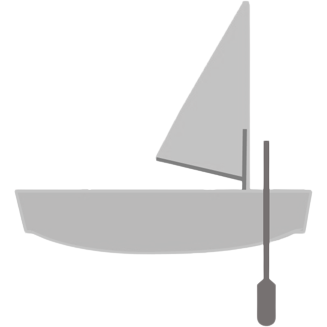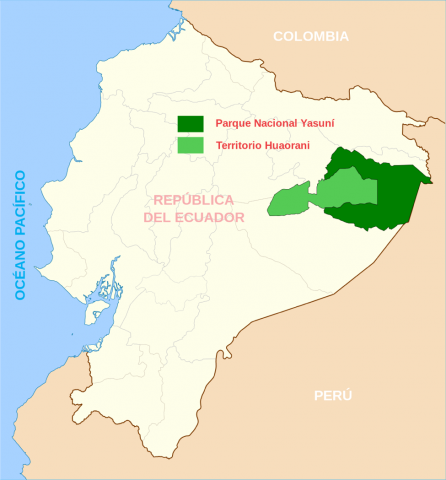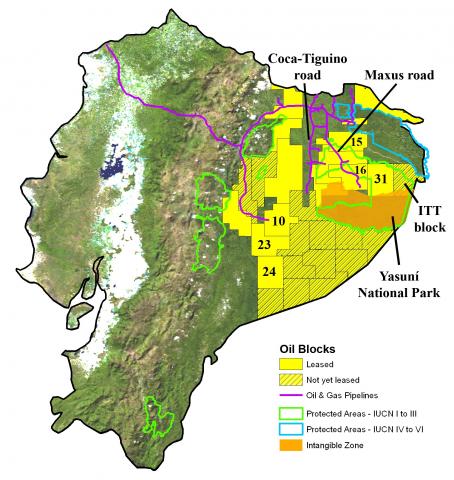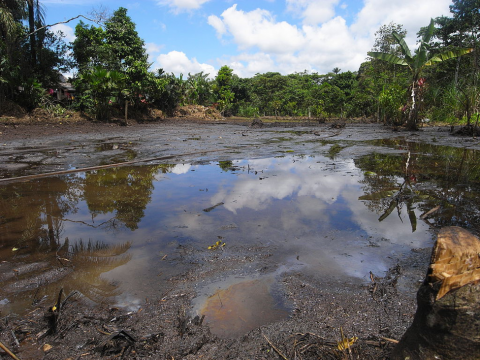The Waorani are a community indigenous to the Eastern Amazon rainforest of Ecuador.
The experience of the Waorani highlights the conflict between development interests and the conservation of irreplaceable biodiversity and ecosystem services. Climate change poses the greatest hazard in the Eastern Ecuadorian Amazon where it is exacerbated by development interests.
In addition to climactic stressors, the ecosystem is undergoing rapid and destructive deforestation, toxic pollution from industrial development, and the disappearance of thousands of unique species. Biodiversity loss and land-use change weaken the resiliency of the greater Amazon ecosystem, as well as the indigenous communities whose culture and livelihoods are reliant on a healthy rainforest.
The Waorani and neighboring communities are fighting for the conservation and preservation of these necessary resources, and their struggle against industrial development highlights one of the greatest challenges of climate change:
How do we relieve the pressure to be part of an extractive, expansionist global economy, and instead find ways to help countries conserve and cultivate the health of the natural world?
The Eastern Amazon of Ecuador
The Waorani were granted land rights to the Waorani Ethnic Reserve in 1990, which spans 2,365 sq. miles and overlaps with Yasuní National Park (Rival 2002).
Yasuní National Park is a UNESCO Man and Biosphere Reserve, located at the convergence of equatorial, Andean, and Amazonian ecosystems (Martin & Scholz 2014, Scott 2013). The location of the park puts it at especially high risk for biodiversity loss, since oil interests overlap with both protected areas and indigenous territories (Zurita-Arthos & Mulligan 2013).
The Waorani call for the preservation and protection of the Amazon, especially as it undergoes stressful climactic changes, and to halt activities that further decrease the resilience of the ecosystem (Amazon Frontlines).
In the Western Amazon, there is a conflict between the exploitation of rich oil reserves and the biodiversity and ecosystem services that the tropical rainforest provides.
Economic Pressure vs. Ecosystem Services
Half of Ecuador’s export earnings originate from the Western Amazon, and Ecuador feels significant economic pressure to exploit petroleum reserves (Zurita-Arthos & Mulligan 2013).
In 2007, the Yasuní-ITT Initiative was proposed, which would have suspended oil operations within an area of Yasuní National Park. In return, the international community was asked to compensate half the projected market value of the reserves, estimated at $3.6 billion dollars. The initiative was abandoned in 2013 (Martin & Scholz 2014).
Yasuní National Park is a UNESCO Man and Biosphere Reserve, located at the convergence of equatorial, Andean, and Amazonian ecosystems, and oil interests overlap both protected areas and indigenous territories (Martin & Scholz 2014, Scott 2013, Zurita-Arthos & Mulligan 2013).
The Waorani are especially threatened by illegal logging, the imposition of oil interests, and the resultant contamination and loss of biodiversity.
Hazards of Climate Change
Climate change hazards in the Eastern Amazon of Ecuador:
- Land-use change exacerbates negative impacts of climate change (HC).
- Climate change inc. loss of biodiversity (MC).
- Poverty: vulnerable to change, low adaptability (HC).
- Inc. in spread/variety of disease (HC).
Hazards directly affecting the Waorani:
- Land use change and biodiversity loss.
- Deforestation of vulnerable and delicate ecosystems.
- Development of extractive industries.
- Pollution and contamination of waterways.
- Degraded ecosystem threatens a traditional foraging lifestyle.
Toxic Spills: Exposure to Hazards of the Petroleum Industry
On one hand, the Amazon is the largest tropical forest on the planet. On the other, it also has the greatest potential for increases in agriculture & development.
The petroleum industry in the Ecuadorian Amazon uses “obsolete technology and poor environmental controls,” resulting in 29,000 barrels of oil spilled between 1994 and 2001, with approximately 7000 of those barrels never recovered (Lessmann et al. 2016).
Effects on health and biodiversity weaken the resilience of the forest and local communities in the face of climate change. Extraction of oil also directly contributes to rising atmospheric CO2 levels and pollution.
The Amazon is one of the most important resources we have in the fight against climate change. We not only risk the destruction of local cultures and an immeasurable amount of biodiversity, but the possibility of losing the Amazon as a carbon sink.
Texaco-Chevron is responsible for spilling billions of gallons of toxic waste in the Amazon during extraction. While they reap the economic benefits of oil exports, the local communities suffer from the adverse health effects of the petroleum industry.
Julien Gomba [CC BY 2.0 (https://creativecommons.org/licenses/by/2.0)]
Exposure to Climate Change Hazards: The Waorani and Eastern Amazonian Ecosystem
Toxic Water
- Drilling muds and formation water from the petroleum industry is frequently stored in open ponds that discharge directly into waterways.
- Downstream communities exposed to "Billions of gallons of untreated toxic wastes" (Lessmann et al. 2016).
- Communities report high cancer rates, livestock die-offs, birth defects, rising rates of spontaneous abortions, and babies and small children with chronic rashes (Berlinger 2009).
Roads and Industrial Infrastructure
- Roads, wells, pipelines, and production facilities directly contaminate and fragment the ecosystems where they are built. Ecosystems around oil sites see a 90% reduction in species (Scott 2013).
- Recent studies have found a "strong positive correlation between oil drilling and deforestation in the region" (Lessmann et al. 2016).
There is a distinct narrative that follows new roads into the rainforest, which are the result of illegal logging and petroleum development: indigenous communities are colonized by those interested in resource extraction, which then “drives deforestation and agriculture expansion,” and transitions the Waorani from a nomadic, foraging lifestyle to one that is increasingly reliant on agriculture and industry assistance to survive (Lessmann et al. 2016).
Vulnerability to Climate Change
This video highlights the importance of the biodiversity of Yasuní National Park, with interviews from biologists and local guides. In the video, they estimate that only 5% of the species in the reserve have been studied, including many medicinal plants.
Fragile Ecosystems and Unique Biodiversity
As a result of Waorani culture and lifestyle’s interdependence with the forest ecosystem, their communities are especially vulnerable to biodiversity losses. Medicine, food, and history is all preserved in the ecology of their environment (Rival 2002).
As climate change puts more stress on ecosystems by changing precipitation patterns and mean temperatures in the rainforest, it is going to increase the pressure on unique and diverse species (WWF). The Waorani, who rely on this biodiversity for foraging and medicine, are put in an especially vulnerable position as they are lost.
Vulnerability of an Animist Cosmology
The cosmology of the Waorani is based upon the forest; the world is called “ome,” or “the forest that is home” (Rival 2002).
The Waorani identify no separation between the consciousness of humans and the consciousness of nature. Through the animist worldview, destroying the surrounding ecosystem destroys the community (Amazon Frontlines).
The imposition of illegal logging, mining, and petroleum extraction directly opposes and destroys the relationship between the Waorani and their “ome,” and is especially vulnerable to the affects of development and the pressure of climate change.
A Language Lost with "Ome"
Language often preserves culture, capturing the way that a society views the world in how they communicate about it. When the Waorani were first contacted in the late 1950’s, “no linguistic congeners [had] been found” (Davis &Yost 1983).
The language that the Waorani use to describe the ecology of their home is especially complex. Not only are parts and functions of each plant described, but the word for a single part of the plant changes based upon what part of it’s life cycle it is in and the interactions it has at that point with other plants or animals (Rival 2002).
Waorani Resistance: Our Land is Not For Sale
As of April 26th, 2019:
The Waorani have won a legal victory in the Ecuadorian court, which would protect 500,000 acres of rainforest from oil extraction. It is now the role of the Ecuadorian government to uphold the court's ruling and support the indigenous rights of the Waorani. Read a letter from tribal leaders below and watch the video to the right for more information about the most recent developments (as of March 2019) in the Waorani resistance movement.
We are Waorani and we have always lived in the Amazon rainforest.
For thousands of years we have defended our territory from trespassers. As a warning, our ancestors left crossed palm-wood spears on trails to give would-be invaders a chance to retreat.
Our ancestor’s bones are buried under this earth. Deer, boar and jaguar still roam free across this land. Our memory, our language, and our songs are borne from the forest, and we will ensure that they live on, generation after generation.
Drilling for oil fuels modern life in the cities, but drilling within our territory threatens everything that matters for our people. We have seen the destruction that oil drilling causes in the rainforest. We have heard neighboring indigenous peoples tell of their children poisoned by contaminated rivers, and seen their bounty of wild fish and game disappear, their language and culture fall to the brink of extinction, all in a single generation.
Our territory gives us life. We will not allow oil-drilling to poison our creeks and our fishing holes. We will not allow lines of explosives to be placed in our hunting grounds for seismic testing. We will not allow the building of platforms or pipelines or roads. We do not recognize what the government calls Oil Block 22. Our forest homeland is not an oil block, it is our life.
These are our words, our palm-wood spears crossed on the jungle trail, our message to the oil companies: Our land is not for sale.
Waorani Territory, Ecuadorian Amazon.
May 19th, 2018.
Resilience and Adaptation to Climate Change
Indigenous Knowledge of Tropical Ecosystems
The Waorani draw resilience from a deep, complex understanding of the ecology of the rainforest, making them an important resource for scientists studying resilience and adaptation of tropical ecosystems, as well as giving the Waorani an in-depth understanding of how climate change is affecting the rainforest. The Waorani are intimately familiar with "ome", the forest that is home, and the complex ecological cycles that exist in the rainforest. The Waorani have a depth of knowledge of the forest that is informed by their cosmology and generations of knowledge, resulting in “sophisitication of their interpretation of biological relationships” that goes beyond basic biological classifications and recognizes the complex interdependence of the animals and plant cycles (Rival 2002).
The Waorani communities are also resilient to disease and health affects of climate change, due to a profound knowledge of the medicinal plants of the rainforest. Just as diverse ecosystems are the most resilient, the Waorani rely on a wide range of wild foods for foraging and are able to adapt their hunting techniques to a changing ecosystem (Davis & Yost 1983).
Active, Organized Resistance
The Waorani have a cultural legacy of resisting colonization and the "sedentarization" of their lifestyle (Rival 2002).
Two groups, the Tagaeri and Taromenane, have gone into voluntary isolation, and have attacked groups of illegal loggers and oil workers as they continue to pave their way into the rainforest (Amazon Frontlines, Pappadarlo et al. 2013).
The Waorani have brought successful court cases against petroleum companies responsible for the pollution and destruction of the land, and garnered international support for the tropical rainforest of Eastern Ecuador. Chevron was ordered to pay 9.5 billion to compensate for the damage done to the Ecuadorian Amazon (Berlinger 2009). Most recently, the court of Ecuador has upheld the right to 500,000 acres of protected land (Amazon Frontlines).
How can the Waorani teach us to be resilient and adapt to the pressures of climate change?
The Waorani could have important things to teach the world about alternative “subsistence strategies” that are dynamic, low-impact, and resilient ways to adapt to changing climactic conditions (Strauss 2012). Western society, which has a disproportionate impact on the environment due to material consumption, natural resource extraction, and the colonization of other cultures, could gain important knowledge from communities like the Waorani. If we are to succeed in making a paradigm shift away from carbon-intensive society, we must learn as much as we can from communities that live in harmony with their environment.The Waorani are a crucial cultural resource if we are to successfully adapt to climate change.
Alaina Ring, Class of 2019
Majors: Geology & Environmental Studies
Alaina is interested in global activism in the fight against climate change, as well as the power of local communities to defend and restore their local ecosystems. She is especially interested in the role that fossil fuel companies play in environmental degradation, land-use change, and the release of greenhouse gases into the atmosphere. In her free time, she loves to ski, read, travel, and play outside with her friends.
References
Amazon Watch. (n.d.). Retrieved from https://amazonwatch.org/
Becker, M. (2014). Resource Extraction and Yasuní National Park: “Ecuador’s Bitter Choice”.
Berlinger, J. (Director), & Berlinger, J., Bonfiglio, M., DeLeon, J. R., & Stratton, R. (Producers). (n.d.). Crude [Video file]. Retrieved from https://www.youtube.com/watch?v=BvrZRvgwBS8
Davis, E.W., Yost, J.A. (1983). The Ethnobotany of the Waorani of E. Ecuador. Botanical Museum Leaflets; Harvard University, Vol. 29(3), 159-217.
Martin, P.L., Scholz, I. (2014). Ecuador’s Yasuní-ITT Initiative: Why did it fail?. International Development Policy, [online], 5.2.
Lessmann, J., Fajardo, J., Muñoz, J., Bonaccorso, E. (2016). Large Expansion of oil industry int the Ecuadorian Amazon: biodiversity vulnerability and conservation alternatives. Ecology and Evolution, Vol. 6(14), 4997-5012.
Pappadolo, S., DeMarch, M., Ferrarese, F. (2013). Uncontacted Waorani in Yasuní Biosphere Reserve: Geographical Validation of the Zona Intangible Tagaeri Taromenane (ZITT). PLOSone, Vol. 8(6).
Butler, Rhett A (2006). “Title of this page (see top of browser window).” Retrieved 9 January 2006, from Mongabay.com / A Place Out of Time: Tropical Rainforests and the Perils They Face. Web site: http://www.mongabay.com/
Rival, L. M. (2002). Trekking in Amazonia, Trekking Through Amazonia: The Huaorani of Amazonian Ecuador (1-19). Colombia University Press.
Rival, L. M. (2002). Schools in the Rain Forest, Trekking Through Amazonia: The Huaorani of Amazonian Ecuador (152-176). Colombia University Press.
Wierucka, A. (2018). Living with Straners: Huaorani and tourism industry in the 21st century, Vol 24(1), 97-110.
Wallace, S. (2013, Jan 11). Rainforest For Sale. National Geographic, 82-119. Retrieved from EBSCOhost.
Zurita-Arthos, L., Mulligan, M., (2013). MultiCriteria GIS Analysis and Geo Visualization of the Overlap of Oil Impacts and Ecosystem Services in the W. Amazon. International Journal of Geoinformatics, Vol. 9.




